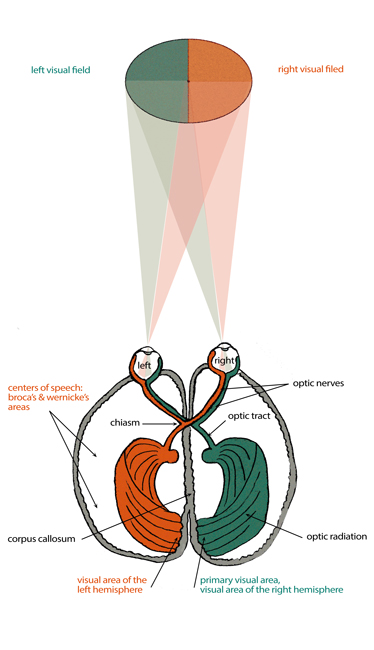Visual Field Dominance
The left hemisphere of the brain controls the functionality of the right side of the body and, therefore, the right side of the face. On the other hand, the left side of the face is controlled by the right hemisphere of the brain. Exceptions of this cross-motor function are found with the nostril wings and the eyeballs, whose movements are controlled by both brain hemispheres equally.
For the eyes there is a separation between the functionality of both fields of vision. The information that both eyes receive, generated from the left field of vision, is processed by the right cortex, and the right visual field is processed by the left cortex.
This is, of course, also the case when you close one eye. The visual information from both visual fields is initially processed individually by each brain hemisphere and subsequently exchanged through the
corpus callosum.
Both brains process the information differently, while still working together.
The left brain is also predominantly responsible for processing logical information. It is here where the centre of speech is found. The left hemisphere is generally a bit larger than the right, since most of us have the tendency to utilise it more.
In the right brain we find the main visual centre. This is not only where the perception of faces is controlled, but also where emotional information is processed.
After deconstructing and mirroring several faces, I realized that I usually recognize almost all my protagonists in their right chimera much more than in their left one.
It is experimentally documented that approximately 80% of people initially prefer the left visual field for face recognition. The visual perception of their counterpart will initially be processed in the “emotional” right brain. In western culture, the left visual field is even more strongly preferred because we write from left to right – and are used to looking at objects from the left first. This means that we first take in the right side of the face of the person in front of us.
I rarely found right-handed people who’s left side of the face is more similar to their original face than their right side. Perhaps the left half of their face is so expressive that this is more prevalent, despite the viewer’s field of view dominance. Naturally my own perception plays a roll here. In my case, I know both the public and private sides of the people near to me. It is interesting that with people that I love, for example, my son, I am more familiar with the left side of his face. Here I find my love reflected again.
